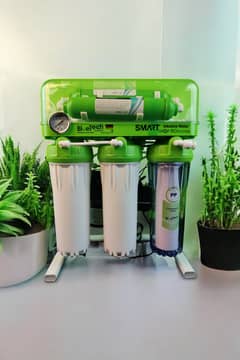1 / 5
Details
ConditionNew
Description
characteristics
Reverse osmosis water treatment equipment for domestic use.
Compact Domestic Reverse Osmosis System for the production of low mineralisation water. Ideal for drinking, cooking, baby bottles and baby food, low sodium diets, ice, infusions and coffee, irons, aquariums and fish tanks, watering flower pots, etc.
This compact model can be installed in areas where space is limited, maintaining all the elements of standard equipment and increasing the hygienic-sanitary reliability as it has disposable cartridges that avoid having to disinfect the cartridge cups.
what is reverse osmosis?
In the reverse osmosis process, water is forced through a membrane, leaving impurities behind. The permeability of the membrane can be so small that practically all impurities are separated from the water.
Description:
Their modern design makes them ideal for integration into the domestic environment, as if they were just another household appliance.
They are easy to install and maintain as they are supplied fully assembled and ready for use.
They incorporate a pressurised membrane tank for the accumulation of treated water and a dispenser tap. The under-sink units are equipped with an external tap for installation at the point of consumption, while the table-top units have a built-in dispenser tap.
Inlet water conditions: Maximum salinity of 1000 to 2500 ppm and potable.
Performance: 90-95% salt reduction.
Conversion ratio from 1:4 to 1:2.8.
Specific characteristics.
COMPACT Reverse Osmosis Equipment.
Daily production: 150 litres.
Easy and intuitive installation, connection and start-up.
Total accessibility for correct maintenance.
In-line 5µm sediment pre-filter cartridge and GAC carbon.
50 GPD Filmtec membrane.
Carbon in-line post-filter cartridge.
Steel tank with plastic coating of 1.5 litres total.
Dimensions: 420 x 240 x 440 mm.
Installation kit.
Tap with ceramic valve.
Maximum salinity: 2500 mg/l
Maximum working pressure: 2,5-6 bar
Working temperature: 5º to 35ºC
Maintenance:
It is recommended to change the carbon filters and the impurity pre-filter every six months.
The membrane should be changed annually if the hardness is higher than 25º HF, otherwise, it is recommended to replace it every two years.
Note: Maximum recommended hardness 40º HF. Higher hardnesses shorten the life of the membrane.
These recommendations are indicative depending on the use of the water and the different chemical parameters of the source water.
Recommendations:
Do not use this system with microbiologically unsafe water or water of unknown quality without adequate pre- or post-system disinfection.
Related ads
Listed by private user
mateen Ali
Member since Jan 2019
See profile
Location
Pakistan
Ad id 1096544436
Report this ad







